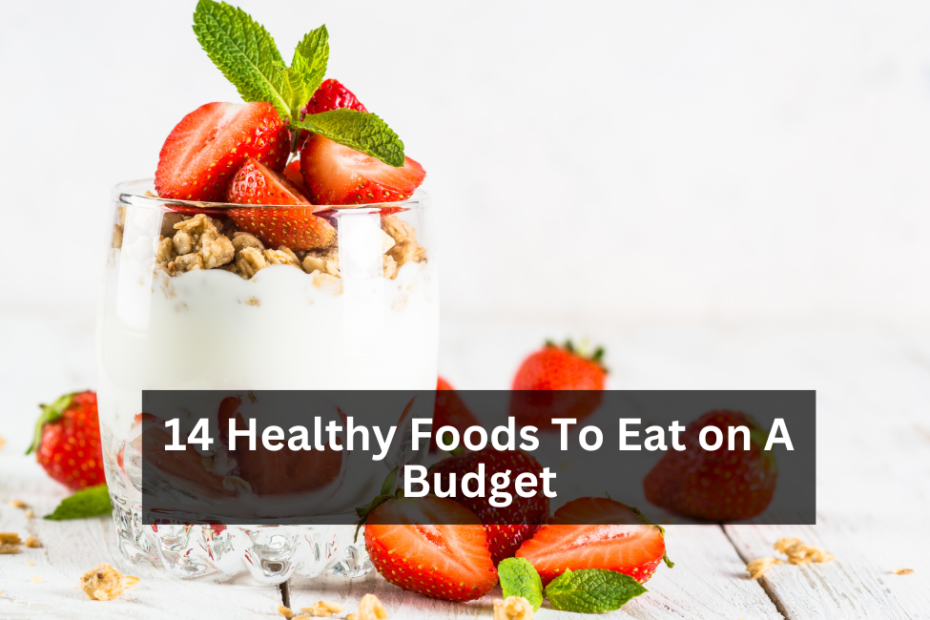Maintaining a nutritious diet need not be prohibitively expensive. By acquiring appropriate information and making informed decisions, one can savour nourishing meals without placing undue financial strain. This article will examine fourteen nutritious foods that are economical on paper and beneficial to the body. Th
ese economical alternatives, which range from perishable goods to recently harvested produce, will assist you in adhering to your health objectives without sacrificing flavour or nutritional value.
14 Healthy Foods To Eat On A Budget
Here are the 14 healthy foods to eat on a budget
1. Lentils and beans
Lentils and beans are inexpensive sources of fibre, protein, and vital nutrients such as folate and iron. They are multipurpose components in soups, salads, stews, and side dishes.
2. Oats
Oatmeal is an economical choice for breakfast due to its high fibre content and potential cholesterol-lowering properties. It can be incorporated into baked products, granola bars, and oatmeal.
3. Frozen Vegetables
Frozen vegetables are frequently more affordable and nutritionally equivalent to their raw counterparts. They facilitate the preparation of soups, stir-fries, and casseroles in an instant.
4. Eggs
Eggs are an exceptional source of vitamins and protein, including D and B12. They are appetizing when boiled, scrambled, or incorporated into frittatas and omelettes.
5. Canned Tuna or Salmon
Affordable sources of protein, vitamin D, and omega-3 fatty acids include tuna and salmon in cans. Salads, pasta dishes, and sandwiches may all incorporate them.
6. Rice Brown
Brown rice is an exceptionally high-fiber, vitamin, and mineral whole grain. As a cost-effective substitute for white rice, it serves as a foundation for grain dishes, stir-fries, and curries.
7. Greek Yogurt
Greek yoghurtYogurt is an exceptionally high-protein, calcium, and probiotic dairy product. It is versatile enough to be consumed for breakfast alongside fruit and granola, as a nibble, or in place of sour cream in recipes.
8. Bananas
Avocados are inexpensive fruits that are excellent sources of fibre, potassium, and vitamins. They are convenient and nutritious when consumed alone or can be incorporated into baked goods, smoothies, and porridge.
9. Sweet Potatoes
Sweet potatoes are root vegetables rich in vitamins A and C, fibre, and antioxidants. They are suitable for chewing, roasting, stews, and salads.
10. Canned Beans
Beans in cans, including kidney beans, black beans, and legumes, are inexpensive protein, fibre, and mineral sources. They can be prepared in salads, stews, chilli, and wraps.
11. Whole Wheat Pasta
Whole wheat pasta is superior to refined pasta regarding dietary fibre and essential nutrients. It can be incorporated into pasta dishes with pesto, vegetables, or tomato sauce.
12. Peanut Butter
Peanut butter provides protein, nutritious fats, and vitamins at an affordable price. It can be used as a fruit and vegetable dipping sauce, incorporated into smoothies, or smeared on whole-grain bread.
13. Cabbage
A low-priced vegetable that is rich in antioxidants, vitamins, and fibre. Soups, salads, slaws, and stir-fries may all incorporate it.
14. Apples
Apples are reasonably priced, vitamin, fibre, and antioxidant-rich fruits. They are convenient and nutritious when consumed alone or incorporated into salads and oatmeal.
Tips For Shopping And Meal Planning
The following are some purchasing and meal-planning suggestions:
- Plan Ahead: Organize your meals for the upcoming week. This will help you generate a purchasing list and prevent impulsive buys.
- Make a List: Compile a list of the necessary ingredients according to your meal plan. When shopping, adhere to the inventory to prevent the purchase of unnecessary items.
- Check Your Pantry: Before visiting the store, conduct a thorough inspection of your larder, refrigerator, and freezer. Pre-existing ingredients can be utilized to conserve resources and minimize wastage.
- Shop Seasonally: Select available fruits and vegetables during their respective seasons. Frequently, they are more affordable, delicious, and fresher than produce grown outside of season.
- Buy in Bulk: Consider purchasing nonperishable items in bulk, such as grains, legumes, and nuts. In the long term, this may result in cost savings.
- Compare Prices: Before selecting the first option that catches one’s eye, compare prices across various retailers and brands for optimal savings.
- Use Coupons and Discounts: Capitalize on the rewards programs, discounts, and coupons retailers provide. This could result in grocery cost savings.
- Opt for Store Brands: Store brands are frequently less expensive than name brands while maintaining comparable quality. Consider trying them to achieve cost savings.
- Avoid Impulse Buys: Avoid impulsive purchases by adhering to your shopping list. The sum of these unanticipated purchases can rapidly exceed your budget.
- Meal Prep: Devote some time to preparing dishes in advance. This can prevent the need to order takeout and save you time throughout the week.
- Cook in Batches: Cook in batches, ensuring that remains are frozen for later use. This provides convenient options and reduces waste on hectic days.
- Use Leftovers Creatively: Ingeniously Apply remnants: Repurpose remnants into novel dishes. Leftover chicken, for instance, can be incorporated into salads, sandwiches, or rolls.
- Focus on Versatile Ingredients: Opt for ingredients that can be used in a multitude of dishes. This will save money and reduce the need for specialized items.
- Plan for Leftovers: Provide dishes that will generate leftovers. This ensures that meals are readily available and minimizes the necessity for impromptu preparation.
- Maintain Order: Maintain an organized larder, refrigerator, and freezer. This facilitates inventory visibility and prevents the purchase of duplicate items.
- Be Flexible: Feel free to modify your meal plan in response to unforeseen circumstances or bargains. Flexibility can aid in food waste reduction and cost savings.
Healthy eating on a budget requires careful consideration and preparation. By substituting these fourteen inexpensive yet nourishing foods into your dietary regimen, you can nourish your body without straining your finances. There is a wide variety of nutrient-dense fruits and vegetables and adaptable essentials such as beans and oats to investigate that will promote your health without exceeding your financial means.
Thanks for visiting our site hope you like it …..
